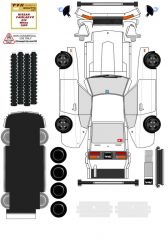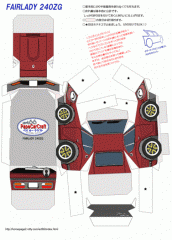-
Posts
505 -
Joined
-
Last visited
Content Type
Profiles
Forums
Blogs
Events
Gallery
Downloads
Store
Everything posted by eec564
-
How many pounds is your pressure plate? Would you have a suggestion for a safe maximum to use?
-

Importance of a tires age.
eec564 replied to BRAAP's topic in Brakes, Wheels, Suspension and Chassis
That's very interesting. I believe my originals are made by Yokohama, I'll check when I get a chance to do stuff at home when it's light out. I'll have my tire guy call his Michelin rep and see what I can get. -Eric -
How many times must you rebuild a holley before you have enough extra parts for another one?
-

Importance of a tires age.
eec564 replied to BRAAP's topic in Brakes, Wheels, Suspension and Chassis
How about those old space-saver spares that came in the S130 and Z31? I still have mine in my car, albeit never used, but twenty plus years old. I've looked around for a mini-doughnut from a newer car I could replace it with, but nothing I find will fit inside the storage area in the fender and bolt up to the car properly. -Eric -
The triangle windows on my 88 300ZX have a minor tint to them, but not the hatch. Taking registration with your name on it and photo ID to a friendly dealer should net you a master code. You can then use that code at a good locksmith shop, but having the dealer cut a new master might earn you a brownie point or two. A really good locksmith shop will be able to cut to the master code and stamp the key with said code if you bring in an original Nissan blank. Duplicates the actual master keys that came with the car and is neat. -Eric
-

leaked coolant when retorquing head gasket
eec564 replied to stravi757's topic in Trouble Shooting / General Engine
Yea, re-torquing head bolts is done one at a time on a cold engine. Loosen one, re-torque to spec, in the factory order of installation. If you lifted the head enough to with the engine full of coolant enough to spill any, odds are you have quite a bit in your oil and vise-versa. Take a very close look at your oil for any signs of milkyness - a change of oil and flush of coolant system may very well be in order. -

leaked coolant when retorquing head gasket
eec564 replied to stravi757's topic in Trouble Shooting / General Engine
Were you loosening them one at a time or all at once? -
Check out the tiny 'Paper Craft' link at the top of this page, seems to be the original source. http://homepage2.nifty.com/art66/index.html The links to my photo album are to the largest size of the pictures I had handy. By all means, have fun! -Eric
-
I'd worry about running more than one lock nut per wheel. Normally the lock nuts aren't hardened and have a generic shape that doesn't always fit wheels absolutely perfectly and have a maximum torque of about 20lbs. Any more and you risk breaking the nut or the key. Because of that I don't like using wheel locks on 4-lug wheels. -Eric
-
Wow. I can't come close to that, but I found these in my web travels. http://album.hybridz.org/showphoto.php?photo=25080&size=big&cat=956 and http://album.hybridz.org/showphoto.php?photo=25081&size=big&cat=956 -Eric
-

Ignition Switch Starting Circuit , Turbo Timer install.
eec564 replied to rayaapp2's topic in S30 Series - 240z, 260z, 280z
I'm presuming that it's an automatic timed turbo timer, from how you're describing it. I'm used to the ones where you push a button to engage them and the unit engages power to the ignition circuit and starts a countdown. I don't see how it could sense via the ignition (blue) wire. Waiting for the ignition power to go off then rapidly switching it back on seems like it could cause lots of issues. It would have to detect ignition on, and at that point start holding the ignition on, then detect key off with the accessory wire and start the countdown. Or it detects via the e-brake wire to know when to kick-on, then senses via something else. Do you have the acc wire tapped in to the car? Try unhooking (if you used nice and easy quick-disconnects) the accessory wire just for fun and seeing if the timer works properly. If it does, you can use that wire to power the relay to cut off the starter without a diode or tapping anything else. The other option would be to build a universal anti-grind circuit. It monitors some function of the engine, such as tach or o2 sensor, and cuts off the starter ANY time the engine is running, completely independently of the turbo timer. -Eric -

Ignition Switch Starting Circuit , Turbo Timer install.
eec564 replied to rayaapp2's topic in S30 Series - 240z, 260z, 280z
The unit HAS to get power from battery + somewhere, it can't simply power itself from the vehicle ignition wire. At the very least the unit would need ground, battery +, and ignition out. How many wires are there coming from the unit (used or unused) and what do they do? -

Ignition Switch Starting Circuit , Turbo Timer install.
eec564 replied to rayaapp2's topic in S30 Series - 240z, 260z, 280z
Alright. Can you tell me what those three wires do, and how you connected them? Did that include power to the unit and ground? Do you have an alarm system, specifically, so you have an alarm system with a starter kill? Presuming a mostly stock Z harness, here's what I'd do. This is assuming you simply have the stock Z ignition switch wired to an ecu relay that powers the ecu and fuel pump, etc, and to a starter relay. Following the attached schematic, wiring in a relay as a starter kill that will be triggered whenever the turbo timer is active. This way when the turbo timer outputs + on its ignition output wire it will supply power to the relay cutting off the key's ability to trip the starter motor and power the vehicle's ignition to keep the car running. The diode will make sure power will not feed from the ignition (as powered by the key) and cut off the starter motor. There IS a catch here, that MUST be noted to prevent fire. The diode must have a current rating sufficient to run the ignition. You can test the current draw of the ignition with a good multi-meter in amp mode. Remove the plug from the back of the ignition switch and hook an amp meter (multi-meter set to the 10-amp scale) to the battery + and ignition wires. This will turn on the car, then hot wire the starter to get things running. Note the current, 0.2 amps or so indicates the ignition is driving one relay and nearly any diode will do. If the current draw is larger, you must use a diode rated to handle it. If the draw is over a few amps, you should consider using a second relay. In that case a diode would not be needed as the ignition out wire from the turbo timer would be used to trip both relays, one to disconnect the starter from the ignition switch and one to connect battery + to the ignition wire. -Eric -

Ignition Switch Starting Circuit , Turbo Timer install.
eec564 replied to rayaapp2's topic in S30 Series - 240z, 260z, 280z
For some reason I couldn't see those pictures on my computer at home. I'm at work now (I'm actually working, shhh, don't tell anyone) and I see what you mean. The very first picture you posted shows the correct wiring for a turbo timer or remote start system with anti-grind. The starter wire is cut and run through the harness so that when the system is active (or the alarm is active, that's what the orange wire input is for, orange is the universal color for alarms 200ma negative output when armed) the starter is disabled. If you're using the vehicle-specific harness from Apexi does it route the starter wire in to the relay box and then to the harness? The battery, ignition and accessory can be a simple tap. -Eric -

Ignition Switch Starting Circuit , Turbo Timer install.
eec564 replied to rayaapp2's topic in S30 Series - 240z, 260z, 280z
I can try to fill you in, but I'll need to know a bunch more about your set up. Wiring things wrong could do a lot of damage. When you say you have a swap, do you mean an S30 with a turbo motor? When you say you have a starter relay, do you mean you use a relay to trip the starter solenoid you aren't passing a large amount of current through the ignition switch? When you refer to installing a diode, exactly where do you mean and for what purpose? Flyback diode on the relay coils? Backfeed diodes on transistor driven circuits? To wire up an anti-grind circuit you install a relay between the ignition switch and (in your case, presuming what I know about your set up) your starter relay. You wire it so when the relay is energized the key cannot engage the starter. It is the same as wiring a starter kill for an alarm system. The difference is rather than having the relay engaged when the alarm is armed, you have it engage when the turbo timer is active. How this is wired will vary with what turbo timer you have. It can be wired with the ignition out wire from some turbo timers, or ideally from a spare 'active' output from the turbo timer. Exactly what turbo timer do you have and how is it wired in to your car? Do you have an ignition relay that handles most of the current required to run the car or does the ignition switch handle large amount of current? I should be able to give you fairly detailed help with that information. -

Ignition Switch Starting Circuit , Turbo Timer install.
eec564 replied to rayaapp2's topic in S30 Series - 240z, 260z, 280z
What you need is a turbo timer with anti-grind. Or just build an anti-grind circuit. Systems with remote start capabilities nearly always have this built in, so when you put the key in and accidentally turn the key too far you don't ruin your starter motor. Rather than simply tapping in to the ignition wire and keeping it on for a specified amount of time, the system taps into main power, ignition power, and intercepts the starter signal from the key. You actually cut your starter wire in the same way as you install a starter kill for an alarm. My remote start is actually part of my alarm, so the anti-grind function is the same as the starter kill, except the alarm has the capability to start the car after isolating the starter switch. You can build this circuit in to a turbo timer system fairly easily, with a single relay (preferably a starter kill relay, as they have 40 amp rated NC contacts and come with a heavy duty socket/harness) and a diode. Actual requirements will vary depending on specific installation (turbo timer used, other modifications to the car) and the current requirement of the ignition circuit. -Eric -

280-ZX, which models received R-180's vs R-200's?
eec564 replied to FiveSeventyZee's topic in S130 Series - 280ZX
There were a bunch of funny production things done to the 280ZX from 79-81. For 82-83 they had things pretty much settled down, and did a mostly decent job of keeping things in line with what they were supposed to be going down the line. -
Should be just over 4 qts. If you're un-sure, simply add 3 qts, wait thirty seconds or a minute or so, and check the oil level with the dip stick. If it's low or not on the dip stick at all, add more oil. Half quart incriments are good. I forget if the difference between the full and empty lines on the VG30 dipstick is one quart or a half, pretty bad since I have one too. Adding a bit at a time, waiting for the oil to drain to the pan, and checking the level is pretty fool proof to not overfill. Simply repeat until full, and make note of how much you added total, so you know for next time. -Eric
-
Also be careful not to simply dump half a quart or a quart or however much in willy-nilly. Check the oil level first and drain/suck/however some out if needed. Overfilling the crank case isn't terribly good for the engine. It also might not hurt to try a better brand of oil when you change it. Some brands of oilare thinner than others at a given weight yet don't burn or leak as much. I've had quite good luck with Castrol GTX for a non-synthetic, and Mobile 1, Valvoline, Castrol, or Amsoil for a synthetic. If you can find it, Archer makes an AMAZING oil, but I think you can only buy it in the 55 gallon drum. Shell Rotella is really nice, but it really is made for diesels and there are far better things to use in our Z cars. -Eric
-
For any car you just bought, if you do not have service records indicating the last time a fluid was changed, assume it has NEVER been changed since the car was new. Go out and change the oil, antifreeze (flush), power steering fluid (flush), brake fluid, clutch fluid, transmission fluid (if it's a manual, be SURE the bottle says GL-4), and diff fluid. For the diff, you MUST remove the fill plug first. Yes, there are MANY types of atf. Off the top of my head, the non-synthetics - Dexron II & III/Mercon, Ford type F, Chrysler +3. Synthetics - Dexron IV/Mercon, Dexron V (rare, NOT Dexron IV/III/II compatible!), Mercon V, Chrysler +4, Nissan CVT, Honda CVT. Then I'm not sure if Toyota Type 4 (TTIV, which supersceded type 3, TTIII or T3) is, but it has BIG warnings on it not to mix with other fluids at all. Amsoil brand fluids are VERY nice synthetics and designed to be compatible with all Dexron/Mercon/F/Chrysler fluids, and should be happy mixed with motor oil in minor quantities. The best non-specialty fluid is the Valvoline brand of Dexron III/Mercon, non-synthetic, avalaible in both qt and gallon. It's cheap, and generic, and oh so nice. Getting harder to find since technically ALL stores are supposed to stop selling non-synthetic ATF because the standards for new vehicles have been supersceeded. Valvoline didn't listen, kept using the Mercon name along side Dexron (on bottles for older cars) even after the brands seperated and the new (for new cars, synthetics) fluids no longer satisfied both standards (there's a Mercon V and Dexron VI) and got in trouble for it.
-
Ahh yes, I forgot. ATF does play better with dino oil than synthetic. Adding some basically thins out the overall viscosity of the oil in your engine and adds a bunch of detergents. Thinner oil runs cooler, check out the Motor Oil "SCHOOL" thread for fun stuffs. Mongo - How much do you use? -Eric
-
Be careful with that. Some transmission fluids do NOT play nice with other types of fluids. Toyota Types 3 and 4 (TTIV) and Chrysler +3/+4 are most certainly different. TTIV is known to gum up when exposed to conventional oils. The general consensus for mixing ATF with motor oil is to use Dexron/Mercon III compatible and being careful not to overfill the crankcase. Adding half a quart willy-nilly sounds dangerious to me. The useful part of ATF3 is its particularly strong detergent and anti-varnish additive package combined with around a 20 weight (I belive) viscosity. Good for un-gumming things, maybe not so good long term or in high concentrations. The ticking you're hearing under the hood is most likely a sticking valve. I do believe you have hydraulic lifters (my 88 NA certainly does) and unless the lifter is seriously damaged and leaking or so clogged it can't fill with oil it shouldn't tick. The sound of a VG30E collapsed lifter before it fills with oil is more of a clack than a click too. -Eric




